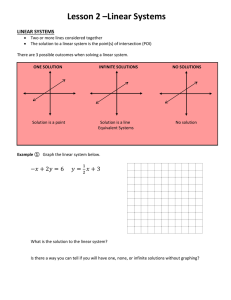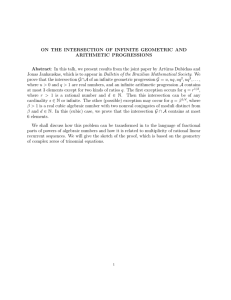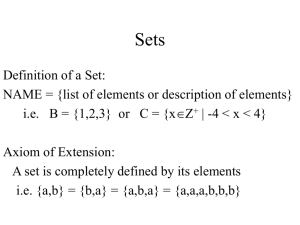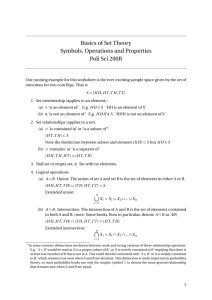Set Theory
advertisement
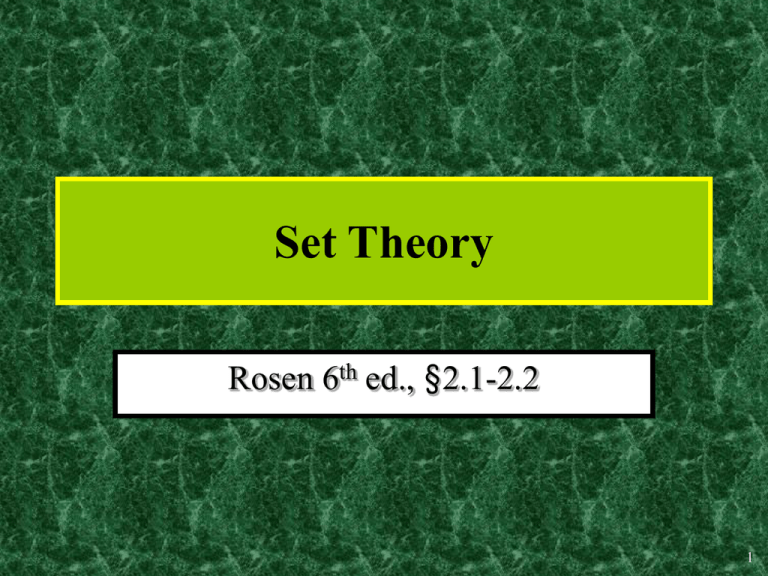
Set Theory
Rosen 6th ed., §2.1-2.2
1
Introduction to Set Theory
• A set is a structure, representing an
unordered collection (group, plurality) of
zero or more distinct (different) objects.
• Set theory deals with operations between,
relations among, and statements about sets.
2
Basic notations for sets
• For sets, we’ll use variables S, T, U, …
• We can denote a set S in writing by listing all of its
elements in curly braces:
– {a, b, c} is the set of whatever 3 objects are denoted by
a, b, c.
• Set builder notation: For any proposition P(x) over
any universe of discourse, {x|P(x)} is the set of all
x such that P(x).
e.g., {x | x is an integer where x>0 and x<5 }
3
Basic properties of sets
• Sets are inherently unordered:
– No matter what objects a, b, and c denote,
{a, b, c} = {a, c, b} = {b, a, c} =
{b, c, a} = {c, a, b} = {c, b, a}.
• All elements are distinct (unequal);
multiple listings make no difference!
– {a, b, c} = {a, a, b, a, b, c, c, c, c}.
– This set contains at most 3 elements!
4
Definition of Set Equality
• Two sets are declared to be equal if and only if
they contain exactly the same elements.
• In particular, it does not matter how the set is
defined or denoted.
• For example: The set {1, 2, 3, 4} =
{x | x is an integer where x>0 and x<5 } =
{x | x is a positive integer whose square
is >0 and <25}
5
Infinite Sets
• Conceptually, sets may be infinite (i.e., not
finite, without end, unending).
• Symbols for some special infinite sets:
N = {0, 1, 2, …} The natural numbers.
Z = {…, -2, -1, 0, 1, 2, …} The integers.
R = The “real” numbers, such as
374.1828471929498181917281943125…
• Infinite sets come in different sizes!
6
Venn Diagrams
7
Basic Set Relations: Member of
• xS (“x is in S”) is the proposition that object x is
an lement or member of set S.
– e.g. 3N, “a”{x | x is a letter of the alphabet}
• Can define set equality in terms of relation:
S,T: S=T (x: xS xT)
“Two sets are equal iff they have all the same
members.”
• xS : (xS)
“x is not in S”
8
The Empty Set
• (“null”, “the empty set”) is the unique set
that contains no elements whatsoever.
• = {} = {x|False}
• No matter the domain of discourse,
we have the axiom
x: x.
9
Subset and Superset Relations
• ST (“S is a subset of T”) means that every
element of S is also an element of T.
• ST x (xS xT)
• S, SS.
• ST (“S is a superset of T”) means TS.
• Note S=T ST ST.
• S / T means (ST), i.e. x(xS xT)
10
Proper (Strict) Subsets & Supersets
• ST (“S is a proper subset of T”) means that
ST but
for ST.
T. /Similar
S
Example:
{1,2}
{1,2,3}
S
T
Venn Diagram equivalent of ST
11
Sets Are Objects, Too!
• The objects that are elements of a set may
themselves be sets.
• E.g. let S={x | x {1,2,3}}
then S={,
{1}, {2}, {3},
{1,2}, {1,3}, {2,3},
{1,2,3}}
• Note that 1 {1} {{1}} !!!!
12
Cardinality and Finiteness
• |S| (read “the cardinality of S”) is a measure
of how many different elements S has.
• E.g., ||=0, |{1,2,3}| = 3, |{a,b}| = 2,
|{{1,2,3},{4,5}}| = ____
• We say S is infinite if it is not finite.
• What are some infinite sets we’ve seen?
13
The Power Set Operation
• The power set P(S) of a set S is the set of all
subsets of S. P(S) = {x | xS}.
• E.g. P({a,b}) = {, {a}, {b}, {a,b}}.
• Sometimes P(S) is written 2S.
Note that for finite S, |P(S)| = 2|S|.
• It turns out that |P(N)| > |N|.
There are different sizes of infinite sets!
14
Ordered n-tuples
• For nN, an ordered n-tuple or a sequence
of length n is written (a1, a2, …, an). The
first element is a1, etc.
• These are like sets, except that duplicates
matter, and the order makes a difference.
• Note (1, 2) (2, 1) (2, 1, 1).
• Empty sequence, singlets, pairs, triples,
quadruples, quintuples, …, n-tuples.
15
Cartesian Products of Sets
• For sets A, B, their Cartesian product
AB : {(a, b) | aA bB }.
• E.g. {a,b}{1,2} = {(a,1),(a,2),(b,1),(b,2)}
• Note that for finite A, B, |AB|=|A||B|.
• Note that the Cartesian product is not
commutative: AB: AB =BA.
• Extends to A1 A2 … An...
16
The Union Operator
• For sets A, B, their union AB is the set
containing all elements that are either in A,
or (“”) in B (or, of course, in both).
• Formally, A,B: AB = {x | xA xB}.
• Note that AB contains all the elements of
A and it contains all the elements of B:
A, B: (AB A) (AB B)
17
Union Examples
• {a,b,c}{2,3} = {a,b,c,2,3}
• {2,3,5}{3,5,7} = {2,3,5,3,5,7} ={2,3,5,7}
18
The Intersection Operator
• For sets A, B, their intersection AB is the
set containing all elements that are
simultaneously in A and (“”) in B.
• Formally, A,B: AB{x | xA xB}.
• Note that AB is a subset of A and it is a
subset of B:
A, B: (AB A) (AB B)
19
Intersection Examples
• {a,b,c}{2,3} = ___
• {2,4,6}{3,4,5} = ______
{4}
20
Disjointedness
• Two sets A, B are called
disjoint (i.e., unjoined)
iff their intersection is
empty. (AB=)
• Example: the set of even
integers is disjoint with
the set of odd integers.
Help, I’ve
been
disjointed!
21
Inclusion-Exclusion Principle
• How many elements are in AB?
|AB| = |A| |B| |AB|
• Example:
{2,3,5}{3,5,7} = {2,3,5,3,5,7} ={2,3,5,7}
22
Set Difference
• For sets A, B, the difference of A and B,
written AB, is the set of all elements that
are in A but not B.
• A B : x xA xB
x xA xB
• Also called:
The complement of B with respect to A.
23
Set Difference Examples
• {1,2,3,4,5,6} {2,3,5,7,9,11} =
___________
{1,4,6}
• Z N {… , -1, 0, 1, 2, … } {0, 1, … }
= {x | x is an integer but not a nat. #}
= {x | x is a negative integer}
= {… , -3, -2, -1}
24
Set Difference - Venn Diagram
• A-B is what’s left after B
“takes a bite out of A”
Chomp!
Set
AB
Set A
Set B
25
Set Complements
• The universe of discourse can itself be
considered a set, call it U.
• The complement of A, written A, is the
complement of A w.r.t. U, i.e., it is UA.
• E.g., If U=N,
{3,5} {0,1,2,4,6,7,...}
26
More on Set Complements
• An equivalent definition, when U is clear:
A {x | x A}
A
A
U
27
Set Identities
•
•
•
•
•
•
Identity:
A=A AU=A
Domination: AU=U A=
Idempotent: AA = A = AA
Double complement: ( A ) A
Commutative: AB=BA AB=BA
Associative: A(BC)=(AB)C
A(BC)=(AB)C
28
DeMorgan’s Law for Sets
• Exactly analogous to (and derivable from)
DeMorgan’s Law for propositions.
A B A B
A B A B
29
Proving Set Identities
To prove statements about sets, of the form
E1 = E2 (where Es are set expressions), here
are three useful techniques:
• Prove E1 E2 and E2 E1 separately.
• Use logical equivalences.
• Use a membership table.
30
Method 1: Mutual subsets
Example: Show A(BC)=(AB)(AC).
• Show A(BC)(AB)(AC).
– Assume xA(BC), & show x(AB)(AC).
– We know that xA, and either xB or xC.
• Case 1: xB. Then xAB, so x(AB)(AC).
• Case 2: xC. Then xAC , so x(AB)(AC).
– Therefore, x(AB)(AC).
– Therefore, A(BC)(AB)(AC).
• Show (AB)(AC) A(BC). …
31
Method 3: Membership Tables
• Just like truth tables for propositional logic.
• Columns for different set expressions.
• Rows for all combinations of memberships
in constituent sets.
• Use “1” to indicate membership in the
derived set, “0” for non-membership.
• Prove equivalence with identical columns.
32
Membership Table Example
Prove (AB)B = AB.
A
0
0
1
1
B AB (AB)B AB
0
0
0
0
1
1
0
0
0
1
1
1
1
1
0
0
33
Membership Table Exercise
Prove (AB)C = (AC)(BC).
A
0
0
0
0
1
1
1
1
B
0
0
1
1
0
0
1
1
C A B ( A B) C A C
0
1
0
1
0
1
0
1
BC
(AC)(BC)
34
Generalized Union
• Binary union operator: AB
• n-ary union:
AA2…An : ((…((A1 A2) …) An)
(grouping & order is irrelevant)
n
• “Big U” notation:
A
i
i 1
• Or for infinite sets of sets:
A
A X
35
Generalized Intersection
• Binary intersection operator: AB
• n-ary intersection:
AA2…An((…((A1A2)…)An)
(grouping & order is irrelevant)
n
• “Big Arch” notation:
A
i 1
• Or for infinite sets of sets:
i
A
A X
36
